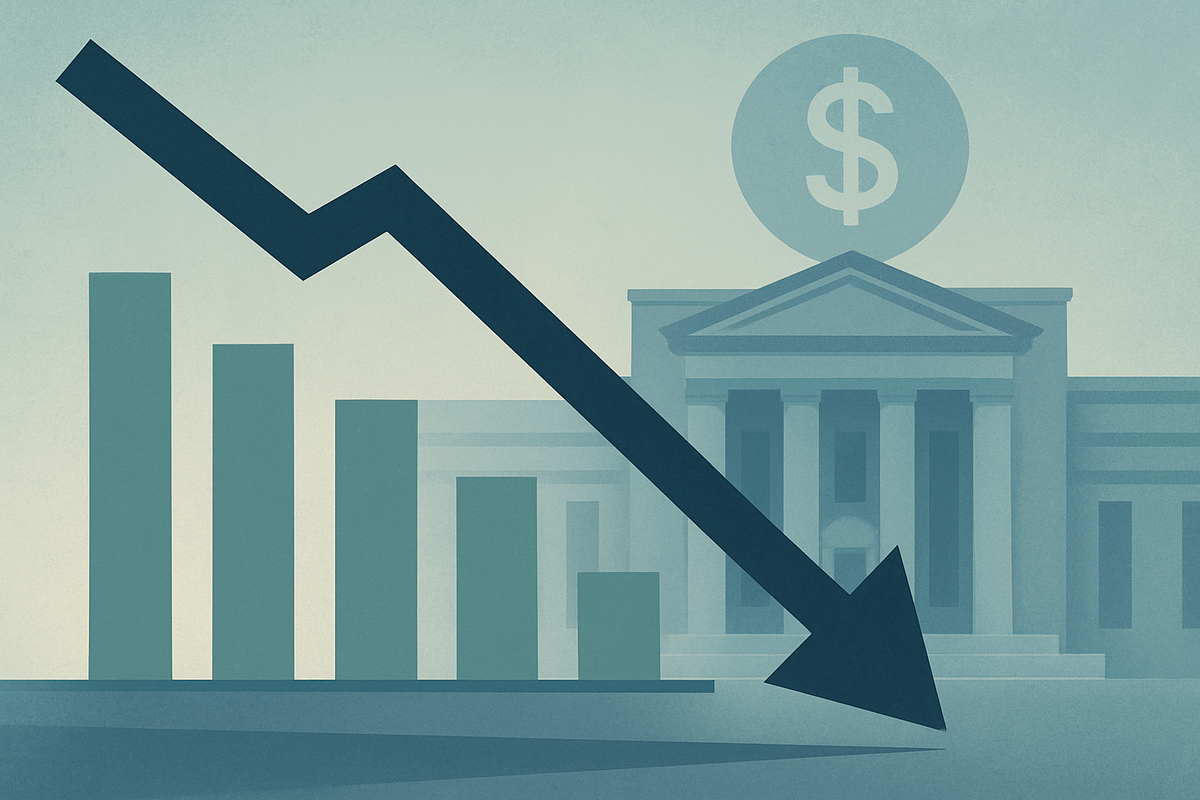Financial News
Federal Reserve Poised for Another Rate Cut Amidst Softening Economy

Financial markets are buzzing with anticipation as the Federal Reserve is highly expected to announce another cut to its key interest rate this Wednesday, October 28, 2025. This move would mark the second such reduction in as many months, following an initial cut in September, and is widely seen as a proactive measure to navigate a softening labor market and persistent, albeit moderating, inflation. Beyond the immediate cut, market participants are keenly watching for signals that the central bank might be preparing for further easing in the coming months, potentially setting the stage for a prolonged period of lower borrowing costs.
The impending decision reflects a shift in the Fed's monetary policy, moving from a tightening stance to one of accommodation. This strategic pivot is driven by a confluence of economic indicators suggesting a need for more supportive financial conditions. A rate cut would directly impact borrowing costs for consumers and businesses, influence mortgage rates, and likely ripple through the stock and bond markets, offering both opportunities and challenges for various sectors of the economy.
Detailed Coverage of the Expected Rate Cut
The consensus among financial institutions and market analysts points to a near-certain 0.25 percentage point (25 basis point) reduction in the federal funds rate target range, bringing it down to 3.75%-4.00%. This follows a similar 25-basis-point cut in September 2025, which was the first reduction in nine months. The timeline leading up to this moment has been characterized by a gradual but discernible weakening in the labor market and a slow, yet steady, cooling of inflation. Federal Reserve officials, including Chair Jerome Powell, have expressed "increasing concern about a sharp slowdown in the labor market," citing "less dynamic and somewhat softer" conditions and rising "downside risks to employment."
Key players involved in this decision-making process are the members of the Federal Open Market Committee (FOMC), who analyze a vast array of economic data to determine the appropriate course for monetary policy. The ongoing government shutdown has complicated matters by delaying the release of the September jobs report, forcing policymakers to rely on alternative and private-sector data. Despite this, the overarching narrative of a weakening employment picture and moderating inflation, which saw the Consumer Price Index (CPI) rise to 3% year-over-year in September 2025 (softer than expected), has solidified the rationale for further easing.
Initial market reactions to the prospect of a rate cut have been generally positive. Mortgage rates, for instance, have already shown a downward trend in anticipation of Fed easing, with the average 30-year fixed mortgage rate recently dipping to 6.19%-6.26%, the lowest in approximately a year. A dovish stance from the Fed is typically viewed favorably by the stock market, as lower borrowing costs can stimulate economic activity and corporate profits. However, the U.S. Dollar Index (ICE: DXY) might experience negative returns due to a less attractive yield environment.
Companies That Might Win or Lose
The Federal Reserve's anticipated rate cut will undoubtedly create winners and losers across various industries. Companies heavily reliant on consumer spending and borrowing are likely to benefit. For instance, homebuilders like D.R. Horton (NYSE: DHI) and Lennar Corporation (NYSE: LEN) could see increased demand as lower mortgage rates make homeownership more affordable. Similarly, retailers such as Amazon (NASDAQ: AMZN) and Walmart (NYSE: WMT) might experience a boost in sales as consumers have more disposable income and access to cheaper credit.
Conversely, some sectors may face headwinds. Banks and financial institutions like JPMorgan Chase (NYSE: JPM) and Bank of America (NYSE: BAC) could see their net interest margins compressed as the difference between what they earn on loans and what they pay on deposits shrinks. However, an increase in loan demand could partially offset this. Additionally, companies with significant cash reserves that rely on higher interest rates for investment income might see a reduction in their earnings. Short-term fixed-income investments, such as money market funds and Certificates of Deposit (CDs) offered by banks, are also likely to experience falling rates, making them less attractive to savers.
The technology sector, often characterized by growth companies that rely on future earnings potential, could be a significant winner. Lower interest rates reduce the discount rate used to value these future earnings, making their stocks more attractive. Companies like Apple (NASDAQ: AAPL) and Microsoft (NYSE: MSFT), with their strong balance sheets and ability to invest in innovation, could see increased investor confidence. The real estate investment trust (REIT) sector, represented by companies like Simon Property Group (NYSE: SPG), could also benefit from lower borrowing costs for property acquisition and development, potentially leading to higher dividend payouts.
Analyzing the Wider Significance
This anticipated rate cut by the Federal Reserve fits into a broader global trend of central banks adjusting monetary policy to address evolving economic conditions. While the U.S. economy has shown resilience, the Fed's proactive approach signals a recognition of potential "downside risks to employment" and a desire to achieve a "soft landing" rather than a recession. This move could encourage other central banks, particularly in developed economies, to consider similar easing measures if their respective economic data warrants it, potentially leading to a synchronized global monetary easing cycle.
The potential ripple effects on competitors and partners are significant. For example, a weaker U.S. dollar, a likely outcome of lower interest rates, could make American exports more competitive on the global stage, benefiting multinational corporations. Conversely, companies that import goods may face higher costs. Regulatory and policy implications could also emerge, with policymakers potentially scrutinizing the impact of sustained low-interest rates on asset bubbles or financial stability. Historically, periods of extended low rates have sometimes led to concerns about excessive risk-taking in financial markets.
Comparisons to similar events in history, such as the "insurance cuts" of the late 1990s, are relevant. In those instances, the Fed cut rates to preemptively address potential economic slowdowns, often successfully extending economic expansions. The current situation, with a combination of moderating inflation and a softening labor market, presents a similar "risk-management" scenario. However, the persistent inflation, even if cooling, adds a layer of complexity not always present in previous easing cycles.
What Comes Next
In the short term, the market will closely scrutinize the Federal Reserve's post-meeting statement and Chair Powell's press conference for any forward guidance. A strong signal for another rate cut in December 2025, which traders are already pricing in with a high probability (around 94-96.7%), would further solidify expectations for a sustained easing cycle. Beyond 2025, analysts from institutions like J.P. Morgan Global Research and Morningstar anticipate additional cuts extending into 2026 and even 2027, with the federal funds rate potentially reaching 2.25%-2.50% by the end of 2027.
Potential strategic pivots or adaptations will be required for businesses and investors. Companies will need to reassess their capital expenditure plans, debt financing strategies, and pricing models in a lower interest rate environment. Investors should consider rebalancing their portfolios to account for shifting dynamics in equity, bond, and currency markets. Market opportunities may emerge in sectors that benefit most from lower borrowing costs and increased economic activity, while challenges could arise for those reliant on higher interest rate income.
Several scenarios and outcomes are possible. A "goldilocks" scenario, where inflation continues to moderate and the labor market stabilizes without a significant downturn, could lead to a gradual and controlled easing cycle, fostering sustained economic growth. Conversely, if inflation proves more stubborn or the labor market deteriorates more rapidly than expected, the Fed might be forced to adjust its pace of cuts, potentially leading to greater market volatility. The geopolitical landscape and global economic conditions will also play a crucial role in shaping the Fed's future decisions.
Comprehensive Wrap-Up
In summary, the Federal Reserve's highly anticipated interest rate cut this Wednesday, October 28, 2025, coupled with the strong possibility of signaling further cuts, marks a significant shift in monetary policy. Key takeaways include the Fed's proactive approach to address a softening labor market and moderating inflation, the immediate impact on borrowing costs and market sentiment, and the potential for a prolonged easing cycle. This move is expected to benefit interest-rate-sensitive sectors like housing and technology, while potentially challenging banks and short-term fixed-income investors.
Moving forward, the market will be keenly focused on the Fed's future guidance, particularly regarding the trajectory of rates into 2026 and beyond. Investors should watch for further economic data, especially labor market reports and inflation figures, as these will heavily influence the central bank's decisions. The interplay between domestic economic conditions, global trends, and geopolitical events will continue to shape the financial landscape. While the immediate outlook appears to be one of cautious optimism, a vigilant approach to market developments and a flexible investment strategy will be paramount in the coming months.
This content is intended for informational purposes only and is not financial advice
More News
View More




Recent Quotes
View More
Quotes delayed at least 20 minutes.
By accessing this page, you agree to the Privacy Policy and Terms Of Service.



